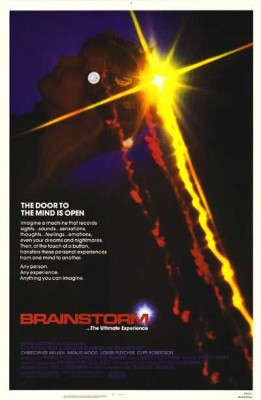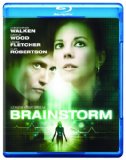| Reviews & Columns |
|
Reviews DVD TV on DVD Blu-ray 4K UHD International DVDs In Theaters Reviews by Studio Video Games Features Collector Series DVDs Easter Egg Database Interviews DVD Talk Radio Feature Articles Columns Anime Talk DVD Savant Horror DVDs The M.O.D. Squad Art House HD Talk Silent DVD
|
DVD Talk Forum |
|
|
| Resources |
|
DVD Price Search Customer Service #'s RCE Info Links |
|
Columns
|
|
|
Brainstorm
The Showscan process utilized the same 65/70mm film used on big gauge roadshows like Lawrence of Arabia and 2001: A Space Odyssey. Showscan, however, photographed and projected film at 60 frames per second rather than the usual 24fps. This resulted not only in an extremely sharp image like Lawrence and 2001, but added smoother, more realistic movement that all but eliminated flicker and blurred imagery. Thirty years after Brainstorm, similarly high frame rate exhibitions are planned on a limited basis for the Avatar sequel and The Hobbit.
Trumbull's original vision for Brainstorm was grand but impractical. To exhibit the film in Showscan meant converting hundreds of 70mm theaters for but a single release. Further, the Showscan process wasn't really perfected; Showscan projectors were extremely noisy, like small aircraft, and many projection booths would have required extra soundproofing/remodeling as well as the specialized equipment. Additionally, the age of big-gauge roadshows had ended a decade earlier after numerous expensive flops, and the industry was extremely resistant to sweeping change. In the early-'80s, even Dolby struggled to find a foothold in the predominantly monophonic marketplace.
And so the decision was made to drop the Showscan process and instead shoot the movie's brainstorm scenes in Super Panavision 70, the same process used on Lawrence and 2001. However, even that was severely compromised. I remember seeing the film in 70mm at the Mai Kai Theater in my hometown. I'd heard about the film's stormy history - star Natalie Wood drowned near the end of production and the movie was almost shelved completely - and was aware that the Showscan process had been abandoned in favor of 70mm. But 70mm still looked pretty darn good, and as is said repeatedly in the film, I was hoping these scenes would still "knock my socks off."
Instead, Brainstorm's brainstorms hardly looked any different from the rest of the film. The aspect ratio changed dramatically, but the image was not significantly sharper. One report suggests all the 65mm material was optically reduced to 35mm during the editing phase and then, once combined with the 35mm material, blown back up to 70mm, which meant Brainstorm as released was much closer to a 35mm film blown-up to 70mm than a part-65mm film released in 70mm format.
In short, the very foundation of the picture, the reason it was made in the first place, was reduced to about 5% of its original potential, leaving only its conventional elements, which were also compromised, though apparently only minimally, by the death of its star before filming had ended.
What's left is a movie where one can see a lot of promise, a few intriguing concepts and performances, but which ultimately is terribly disappointing.
Warner Home Video's Blu-ray approximates the original theatrical experience, but almost unavoidably makes matter even worse. The brainstorm sequences are presented in 2.4:1 format, while the rest of the picture, about 75%, is windowboxed to around 1.66:1. Instead of a normal-looking movie that occasionally opens up to becomes even bigger and more spectacular, it looks like a reduced, 4:3 letterboxed movie that occasionally opens up to become a normal one. The brainstorm sequences don't look any sharper on Blu-ray than they did in 70mm, and probably the original 65mm elements weren't accessed because of the expense involved.
Scientists Michael Brace (Christopher Walken) and his brilliant, chain-smoking colleague, Lillian Reynolds (Louise Fletcher), along with technicians Hal Abramson (Joe Dorsey) and Gordo (Jordan Christopher), test a prototype of the device, recording Gordo's sensations as he eats various foods, and later as he rides a flight simulator. At the urging of supportive CEO Alex Terson (Cliff Robertson), a Cinerama-type film is made complete with rollercoaster rides (as in This Is Cinerama) and flyovers of the Golden Gate Bridge (How the West Was Won).
Brace and Reynolds are still testing the device and only beginning to comprehend its seemingly limitless potential. Gordo stumbles on its obvious use in pornography, recording a sexual encounter. But when he shares the recording with Hal and Hal splices it into an endless loop of climatic orgasms its dangerously addictive aspects are made plain.
Conversely, Brace records estranged wife Karen (Natalie Wood) during a visit to the lab - she's working to develop a more practical, saleable model of the headset - and he discovers that he can experience her emotions about their failed relationship, the good as well as the bad. He, in turn, shares his feelings through the device, and via this viscerally empathetic experience they decide to get back together.
Inevitably, the military gets wind of the technology, and seeing its potential for everything from training to enhanced interrogation their conflict with the scientists drives the rest of the film.
Location footage was shot during the fall of 1981, but in late November Natalie Wood, on a weekend boating trip with Walken and husband Robert Wagner, drowned off Catalina Island. The cause of her mysterious death has never satisfactory been answered. Brainstorm was almost scuttled as a result, though Wood's death may only have been a pretense, an excuse to collect the insurance on a commercially iffy feature. There's little evidence in the film that major scenes had to be cut or substantially altered because of Wood's death. She's in the film beginning to end, and never mysteriously absent. Indeed, the best thing about Brainstorm, that an estranged couple could experience the other person's emotions about their relationship, appears pretty much intact.
Much was made at the time of Louise Fletcher's colorful performance, which is indeed excellent though she may be the least convincing chain-smoker in the history of movies. (Researching this I was surprised to learn that, apparently, she was a smoker at that time. Onscreen though, she looks like a non-smoker pretending to be one.) As good as she is, however, her subplot moves the film in directions that should have been avoided.
The film unwisely tries to depict the experience of death (featuring literal angels, no less), always an unwise move as such things can never ever ever mesh with audience preconceptions. But the device as relationship tool is intriguing, and there are clever little ideas throughout. An early scene shows Reynolds hitting Gordy, wearing the camera, with a knee hammer. Both Gordy and Brace, the latter wearing the receiver, reflexively kick their legs simultaneously.
Video & Audio
Brainstorm looks okay on Blu-ray, but for reasons described above maintaining the original theatrical aspect ratio on this show has serious drawbacks. Even on large monitors the 1.66:1 windowboxed footage (most of the film) is too small, while the 2.4:1 brainstorm sequences don't stand out enough to make any significant impact. The 5.1 DTS-HD Master Audio is somewhat better, as in theaters, and the transition back-and-forth is more pronounced aurally. Also included is a 1.0 Dolby Digital Spanish track, and English, Spanish, and French subtitle options.
Extra Features
The lone extra is a trailer that's even grainier than the feature presentation, and which really undersells the picture.
Parting Thoughts
More a curiosity than satisfying entertainment, for its performances, a few good ideas, and an adult approach to the material, Brainstorm is still worthwhile. Recommended.
Stuart Galbraith IV is a Kyoto-based film historian whose work includes film history books, DVD and Blu-ray audio commentaries and special features. Visit Stuart's Cine Blogarama here.
|
| Popular Reviews |
| Sponsored Links |
|
|
| Sponsored Links |
|
|
| Release List | Reviews | Shop | Newsletter | Forum | DVD Giveaways | Blu-Ray | Advertise |
|
Copyright 2024 DVDTalk.com All Rights Reserved. Legal Info, Privacy Policy, Terms of Use,
Manage Preferences,
Your Privacy Choices | |||||||















